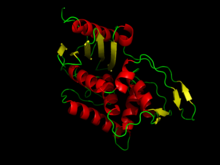DD-transpeptidase
| Serine-type D-Ala-D-Ala carbboxypeptidase | |||||||||
|---|---|---|---|---|---|---|---|---|---|

Structure of the streptomyces K15 DD-transpeptidase
|
|||||||||
| Identifiers | |||||||||
| EC number | 3.4.16.4 | ||||||||
| CAS number | 9077-67-2 | ||||||||
| Databases | |||||||||
| IntEnz | IntEnz view | ||||||||
| BRENDA | BRENDA entry | ||||||||
| ExPASy | NiceZyme view | ||||||||
| KEGG | KEGG entry | ||||||||
| MetaCyc | metabolic pathway | ||||||||
| PRIAM | profile | ||||||||
| PDB structures | RCSB PDB PDBe PDBsum | ||||||||
|
|||||||||
| Search | |
|---|---|
| PMC | articles |
| PubMed | articles |
| NCBI | proteins |
DD-transpeptidase (EC 3.4.16.4, DD-peptidase, DD-transpeptidase, DD-carboxypeptidase, D-alanyl-D-alanine carboxypeptidase, D-alanyl-D-alanine-cleaving-peptidase, D-alanine carboxypeptidase, D-alanyl carboxypeptidase, and serine-type D-Ala-D-Ala carboxypeptidase.) is a bacterial enzyme that catalyzes the transfer of the R-Laca-D-alanyl moiety of R-L-aca-D-alanyl-D-alanine carbonyl donors to the γ-OH of their active-site serine and from this to a final acceptor. It is involved in bacterial cell wall biosynthesis, namely, the transpeptidation that crosslinks the peptide side chains of peptidoglycan strands.
The antibiotic penicillin irreversibly binds to and inhibits the activity of the transpeptidase enzyme by forming a highly stable penicilloyl-enzyme intermediate. Because of the interaction between penicillin and transpeptidase, this enzyme is also known as penicillin-binding protein (PBP).
DD-transpeptidase is mechanistically similar to the proteolytic reactions of the trypsin protein family.
Crosslinking of peptidyl moieties of adjacent glycan strands is a two-step reaction. The first step involves the cleavage of the D-alanyl-D-alanine bond of a peptide unit precursor acting as carbonyl donor, the release of the carboxyl-terminal D-alanine, and the formation of the acyl-enzyme. The second step involves the breakdown of the acyl-enzyme intermediate and the formation of a new peptide bond between the carbonyl of the D-alanyl moiety and theamino group of another peptide unit.
Most discussion of DD-peptidase mechanisms revolves around the catalysts of proton transfer. During formation of the acyl-enzyme intermediate, a proton must be removed from the active site serine hydroxyl group and one must be added to the amine leaving group. A similar proton movement must be facilitated in deacylation. The identity of the general acid and base catalysts involved in these proton transfers has not yet been elucidated. However, the catalytic triad tyrosine, lysine, and serine, as well as serine, lysine, serine have been proposed.
Transpeptidases are members of the penicilloyl-serine transferase superfamily, which has a signature SxxK conserved motif. With "x" denoting a variable amino acid residue, the transpeptidases of this superfamily show a trend in the form of three motifs: SxxK, SxN (or analogue), and KTG (or analogue). These motifs occur at equivalent places, and are roughly equally spaced, along the polypeptide chain. The folded protein brings these motifs close to each other at the catalytic center between an all-α domain and an α/β domain.
...
Wikipedia
